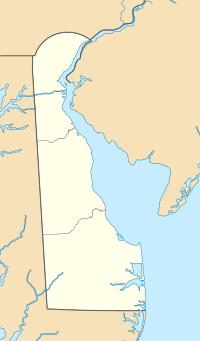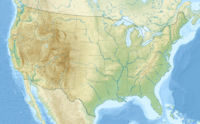Hyde Run (Red Clay Creek tributary) facts for kids
Quick facts for kids Hyde Run |
|
|---|---|
|
Location of Hyde Run mouth
|
|
| Other name(s) | Tributary to Red Clay Creek |
| Country | United States |
| State | Delaware |
| County | New Castle |
| Physical characteristics | |
| Main source | divide between Hyde Run and Mill Creek pond in Stuyvesant Hills, Delaware 325 ft (99 m) 39°46′43″N 075°39′44″W / 39.77861°N 75.66222°W |
| River mouth | Red Clay Creek Faulkland, Delaware 60 ft (18 m) 39°44′38″N 075°38′01″W / 39.74389°N 75.63361°W |
| Length | 1.94 mi (3.12 km) |
| Basin features | |
| Progression | generally southeast |
| River system | Christina River |
| Basin size | 2.54 square miles (6.6 km2) |
| Tributaries |
|
| Bridges | Old Wilmington Road, Longbow Terrace, Lancaster Pike, Westgate Drive, Ambleside Drive, Cheltenham Road, Hercules Road, DE 41. Faulkland Road, DE 41 |
Hyde Run is a small stream, about 1.94 miles (3.12 km) long. It flows into a bigger stream called Red Clay Creek in New Castle County, Delaware. Think of it like a small branch joining a larger river.
What's in a Name?
Sometimes, streams and rivers have different names over time. Hyde Run has also been known as Clark's Run or Hyde's Run in the past. This information comes from a system that keeps track of place names.
The Journey of Hyde Run
Hyde Run starts from a pond in an area called Stuyvesant Hills, Delaware. This pond is near the dividing line between Hyde Run and another stream called Mill Creek.
From its start, Hyde Run flows towards the southeast. It eventually joins Red Clay Creek in a place called Faulkland, Delaware. This meeting point is inside Brandywine Springs Park, a lovely natural area.
Understanding the Watershed
A watershed is like a big bowl where all the rain and snow that falls eventually flows into a specific stream or river. The Hyde Run watershed covers about 2.54 square miles (6.58 square kilometers).
This area gets about 46.5 inches (118 cm) of rain and snow each year. About 16% of the land in the Hyde Run watershed is covered by forests. These forests help keep the water clean and provide homes for wildlife.



